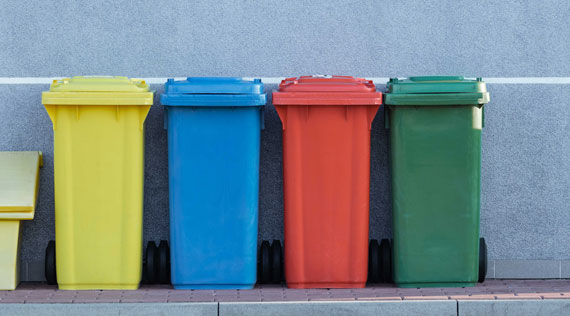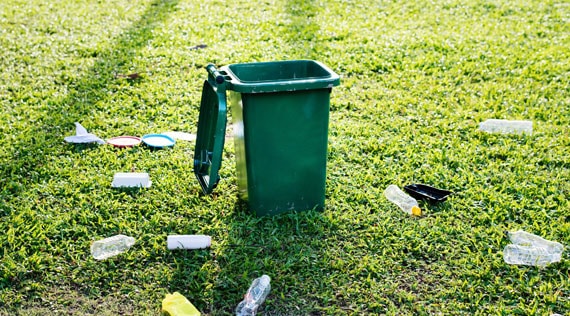Omaha residents this week kick their old trash cans and green recycling bins to the curb as the city ushers in a new era of solid waste collection.
Beginning Monday, most of the city’s 150,000 households will put their garbage, recycling and yard waste in two 96-gallon covered carts on wheels that the city’s new waste hauler, FCC Environmental Services, has been delivering to residences since August.
The city approved a 10-year, $24.2 million contract with FCC in 2019 that includes two optional five-year extensions.
In preparation for the transition, FCC has been running practice routes with a new fleet of 72 white garbage trucks that are powered by compressed natural gas. The new trucks have automated arms that will do a lot of the heavy lifting: In neighborhoods that are more spread out, the truck driver will use a joystick to operate the arm, picking up and dumping carts directly into the back of the vehicle.
In older parts of the city, where the streets are narrower and fewer people have garages, a helper on the truck will load carts onto the mechanical arm.
Some Omahans already know how this will go: In the fall of 2016, the city selected about 2,500 homes for a pilot program to test a two-cart system with automated pick-up.
“The feedback was overwhelmingly positive,” Omaha Mayor Jean Stothert said at a press conference earlier this month. “After the pilot, even the homeowners who didn’t want to participate told us they loved the covered carts and they wanted them back.”
Bob Sedlak, president of the Skylark-Cryer Neighborhood Association, was one of the pilot participants. He said many people in the neighborhood northeast of 120th Street and West Center Road did come to appreciate the additional room the carts afford for trash and recyclables.
But the most common complaint, Sedlak said, was one that many Omahans are experiencing now: Some houses and yards don’t have a lot of space to store the carts, which are larger than the cans most people use.
Sedlak plans to store his carts along a fence in the backyard. He said it could be a challenge to maneuver them when there’s snow on the ground.
“I guess we’ll find out (this) week how it goes,” he said.
Here’s what you need to know ahead of the transition:
The basics
One of the carts, with a black lid, must be used for trash and yard waste. It will be collected weekly.
The other cart, with a green lid, is used for recycling, which will be collected every other week.
Your current collection day will not change.
To ensure a safe, efficient collection process, people should avoid placing the carts directly next to each other or near mailboxes or parked cars, Dan Brazil, FCC’s director of collection services, said during a recent press event. The space will make it easier for employees to maneuver the automated arm that grabs the carts, he said.
Carts should be spaced about 3 feet apart if possible.
In older neighborhoods where it isn’t possible to space out the carts, a helper will load them onto the truck.
The lids attached to the carts must be fully closed when they are set out each week. Jim Theiler, assistant director for environmental services for the city’s Public Works Department, said the carts should do a better job than current cans and recycling bins of keeping debris contained.
“The neighborhoods will be a little bit cleaner,” Theiler said.
Each cart is equipped with an electronic chip that ties the cart to the residence where it was delivered. If you move homes, the carts stay behind.
What do I do with my old trash cans and recycling bins?
Beginning Monday, Omahans can bring their old trash cans and green recycling bins to FCC’s facility at 5902 N. 16th St.
People can also place the green recycling bins in the new recycling cart. Old trash cans can be put in the trash and yard waste cart.
Some people are opting to repurpose their green recycling bins into flower containers and storage bins. They’re also useful to store glass products, which can be taken to the city’s recycling drop-off sites.
The carts are too big. Can I get smaller ones?
Yes, but the city is asking people to try out the 96-gallon carts for three months. At that time, you can request carts that are half the size of the big ones.
The city also offers a program for people who need assistance with their waste collection. Residents who are 70 or older, or have a verified medical need, can request that crews collect their carts from a location of their choice — near their house, for example.
People interested in the program can call 402-444-5238 to register.
Families of five or more can request an extra trash or recycling cart at no cost. To get one, you must fill out a form, get it notarized and send it to the city.
What’s new with yard waste?
Throughout the year, Omahans can place materials like grass clippings, garden plants and twigs, along with trash, in their cart with a black lid. Christmas trees, too, will be accepted if they fit in the cart.
In 2021, Omahans will be able to put out an unlimited number of yard waste bags during a four- to six-week period in the spring and fall. During those times, yard waste will go to Oma-Gro, the city’s composting facility.
During the rest of the year, yard waste will go to the landfill. People with excess yard waste outside of the unlimited collection periods can purchase stickers from various stores to place on brown yard waste bags or bundles of branches. Each bag or bundle must have its own sticker, and the branches cannot exceed 4 feet in length or 2 inches in diameter.
The stickers, which cost $1.98 plus tax, will be sold at Hy-Vee, Family Fare, Supermercado Nuestra Familia, Westlake Ace Hardware, Ideal Hardware and Menards locations.
Nothing can be placed outside of carts other than yard waste bags and bundles, and lids on the carts must be able to fully close.
The Oma-Gro facility, 15705 Harlan Lewis Road in Bellevue, also accepts yard waste.
What about recycling?
One of the 96-gallon recycling carts is about five times the size of a green recycling bin. Now that every Omaha household has a recycling cart, the city expects the amount of recycling to increase by 20% or more, though other cities that have switched to carts have seen much larger increases.
The city is still working to secure a long-term contract with a recyclables processing company because the contract with current processor Firstar Fiber expires at the end of the year. In October, the Omaha City Council rejected a contract with NebraskaLand Recycling.
In the meantime, the city is planning to amend its hauling contract with FCC so that FCC can take recyclables to multiple processors. The company already has made deals with Firstar and NebraskaLand.
That would be a temporary agreement until Stothert and the Public Works Department rebid a long-term contract with a single company.
People who produce a lot of recyclables can drop them off at five full-service recycling drop-off sites.
Two of the drop-off sites moved recently. The former site near 75th and Corby Streets is now at 10910 Emmet St. a block north of West Maple Road.
A former site near 26th and Douglas Streets is now located near 17th and Burt Streets on the Creighton University campus.
Stothert said those locations are larger, allowing crews to more easily manage the volume of recyclables.
More information about the city’s transition to covered carts can be found at wasteline.org.

